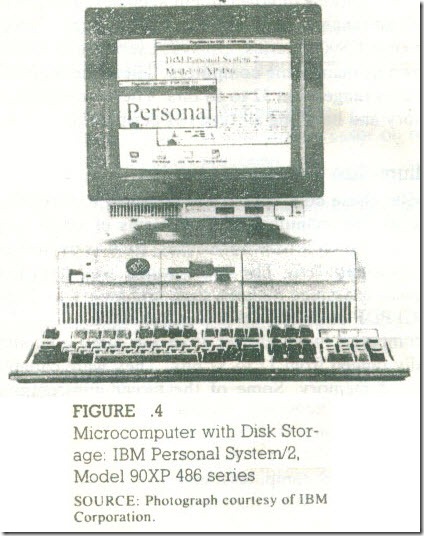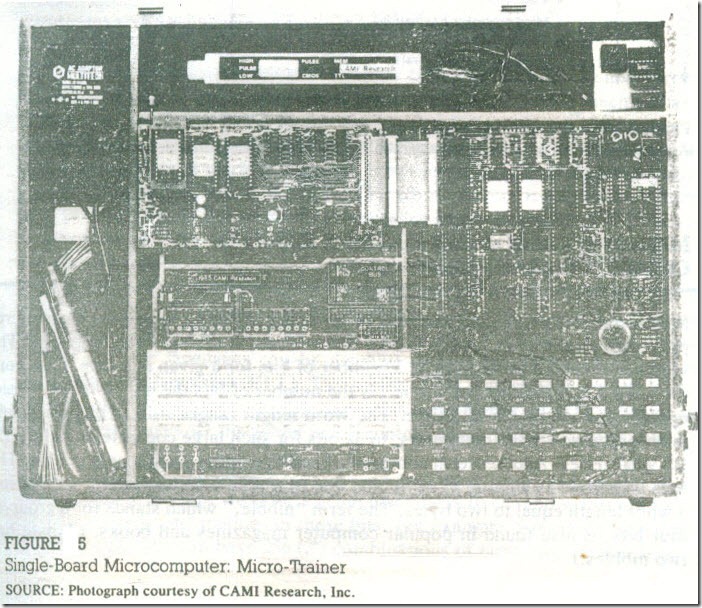How Does the Microprocessor Work?
Assume that a program and data are already entered in the RJW memory. (How to write and execute a program will be explained later.) The program includes binary instructions to add given data. and to display the answer at the seven segment LEUs. When the microprocessor is given a command to execute the program, it reads and executes one instruction at a time and finally sends the result to the seven-segment LEDs for display.
This process of program execution can best be described by comparing it to the process of . assembling a radio kit .The instructions for assembling the radio are printed in a sequence on a sheet of paper. One reads the first instruction, then picks up the necessary components of the radio and performs the task. The sequence of the process is read. Interpret , and perform, The microprocessor works the same way. The instructions are stored sequentially in the memory. The microprocessor fetches the-first instruction from its memory sheet, decodes it, and executes that instruction. The sequence off etch. decode. and execute is continued until the microprocessor comes across an instruction to stop, During the entire process, the microprocessor uses the system bus to fetch the binary instructions and data from the memory. It uses registers from the register section to store data temporarily. and it performs the computing function in the ALU section. Finally, it sends out the result in binary. using the same bus lines ,to the seven segment LEDs.
Summary of Important Concepts
The functions of various components of a microprocessor-based system can be summarized as follows:
1. The microprocessor
· communicates with all peripherals(memory and I/Os) using the system bus.
· controls timing of information flow.
· performs the computing tasks specified in a program
2. The memory .
· stores binary instructions and data, called programs.
· provides the instructions and data to the microprocessor on request.
· stores results and data for the microprocessor.
3. The input device
· enters data and instructions under the control of a program such as a monitor program.
4. The output device
· accepts data from the microprocessor as specified in a program.
5. The bus
· carries bits between the microprocessor and memory and I/Os.
FROM LARGE COMPUTERS TO S~GLE-CHIP MICROCONTROLLERS
In the last thirty years, advances in semiconductor technology have had an unprecedented impact o-n computers. Thirty years ago, computers were-accessible only to big corporations, universities, and government agencies. Now, "computer" has become a common word. The range of computers now available extends from such sophisticated, multimillion-dollar machines as the Cray computers to the less-than-$1000 personal computer. All the computers now available on the market include the same basic components shown in Figure 3. Nevertheless, it is obvious that these computers are not all the same.
Different types of computers are designed to serve different purposes. Some are suitable for scientific calculations, while others are used simply for turning appliances on and off. Thus, it is necessary to have an overview of the entire spectrum of computer applications as a context for understanding the topics and applications discussed in this text. Until twenty years ago. computers were broadly classified in three categories: mainframe, mini-, and microcomputers. Since then, technology has changed considerably, and the distinctions between these categories have been blurred. Initially, the microcomputer was recognized as a computer with a microprocessor as its CPU. Now practically all computers have various types of microprocessors performing different functions within the large CPU. For the sake of convenience, computers are classified here as large .computers, medium-size computers, and microcomputers.
Large Computers
These are large, general-purpose computers designed to perform such data processing tasks as complex scientific and engineering calculations and handling records for large corporations or government agencies. The price is generally beyond $1 million and can range from $10 to $20 million. Typical examples of these computers are the IBM ES9000 series, Unisys A series, and Cray computers; they are generally known as mainframe computers. These are high-speed computers, and their word lengths range from 32 to 64 bits. They are capable of addressing megabytes of memory and handling all types of peripherals.
Medium-Size Computers
In the late 1960s, these computers were designed to meet the instructional needs of small colleges, the manufacturing problems of small factories, and the data processing tasks of medium-size businesses, such as payroll and accounting. They were called minicomputers. The price range was anywhere from $25,000 to $100,000. Typical examples include such computers as Digital Equipment Corporation (DEC) PDP 11/45 and Data General Nova.
These computers were slower than the large computers, and their word length generally ranged from 12 to 32 bits. They were capable of addressing 64K to 256K bytes of memory. Some of the larger minicomputers were known as midi computers. However, these classifications are no longer valid. For example, Digital Equipment’s VAX series is a 32-bit machine with megabytes of memory addressing capacity. The price ranges from $25,000 to $450.000. The high-end models of the VAX 9000 systems are classified as mainframe computers.
Microcomputers
The 4-bit and 8-bit microprocessors became available in the early 1970s, and initial applications were primarily in the areas of machine control and instrumentation. As the price of the microprocessors and memory began to decline, the applications mushroomed in almost all areas, including video games, word processing, and small business applications. Early arrivals in the microcomputer market, such as Cromemco, North Star Horizon, Radio Shack TRS-80, and Apple, were designed around 8-bit microprocessors. Since then. 16-bit and 32-bit microprocessors such as Intel 8086/88, 80286,80386. 80486; Motorola 68000; and Zilog Z8000 have been introduced, and recent microcomputers have been designed around these microprocessors. Present-day microcomputers can be classified into three groups: business (or personal), single-board, and single-chip microcomputers.
BUSINESS MICROCOMPUTERS
These microcomputers are being used for a variety of purposes, such as payroll, business accounts, word processing, legal and medical recordkeeping, personal finance, and instruction. They are also known as personal computers. Typically, the price ranges from $1,000 to $5,000 for a single-user system, and it can go higher for a multi-user system. Examples include the IBM personal computer (PC, XT, AT, and personal system 2 series). AT&T 6300 series, Apple and Macintosh, Zenith, and Compaq computers. Figure 4 shows an example.
FIGURE 4
Microcomputer with Disk Storage: IBM Personal System/2. Model 90XP 486 series
SOURCE: Photograph courtesy of IBM Corporation.
At the low end of the microcomputer spectrum, a typical configuration includes a 16-bit microprocessor, 512K (or higher) bytes of system memory, a cathode ray tube (CRT) terminal. a dot matrix printer, dual disk drive for 5V4- and 3V2-inch floppy disks, and a 40 to 80 megabyte (MB) hard disk. The floppy disk is a magnetic medium similar to a cassette tape except that it is round like a record. Information recorded on these disks can be accessed randomly using disk drives. Conversely, information stored on a cassette tape is accessed serially. In order to read information at the end of the tape, the user must run the entire tape through the machine. The hard disk is similar to the floppy disk except that the magnetic material is coated on a rigid aluminum base that is enclosed in a sealed container and permanently installed in a microcomputer. The hard disk and the floppy disk are used to store programs semi permanently, i.e., the binary information does not disappear when the power is turned off. However, the microprocessor does not have direct access to this information; it must copy this information (programs) into system memory. The hard disk has a large storage capacity; therefore, large and frequently used programs such as compilers, interpreters, system programs. and application programs are stored on this disk. The floppy disk is generally used for user programs. At the high end of the microcomputer spectrum, the basic configuration remains essentially similar. It may include a high-speed, 16- or 32· bit microprocessor, a hard disk with 80 to 120 MB of storage, two disks, a high resolution CRT terminal, and a laser printer.
SINGLE-BOARD MICROCOMPUTERS
These microcomputers are used primarily in college laboratories and industries for instructional purposes or for evaluating the performance of a given microprocessor . They can also be part of some larger systems. Typically, these microcomputers include an 8-bit microprocessor, from 256 to 2K bytes of user memory ,a Hex keyboard, and seven-segment LEDs for display. The system monitor programs of these computers are generally small; they are stored in less than 2K bytes of ROM. The prices of these single-board computers range from $100 to $800, with the average price being about $300.
Examples of these computers include such systems as Intel SDK-85, Motorola Evaluation Kit. E&L Instrument Fox Micro trainer , and CAMI Research Micro-Trainer (Figure 5). These are generally used to write and execute assembly language programs and to perform interfacing experiments.
SINGLE-CHIP MICROCOMPUTERS (MICROCONTROLLERS)
These microcomputers are designed on a single chip, which typically includes a microprocessor, 64 bytes of R/W memory, from I K to 2K bytes of ROM, and several signal lines to connect I/0s. These are complete microcomputers on a chip; they are also known as microcontrollers. They are used primarily for functions such as controlling appliances and traffic lights. Typical examples of these microcomputers include the Zilog Z8, Intel MCS 51 and 96 series, and Motorola 68HCII.
The entire spectrum of computer applications is shown in Figure 6, and various applications and categories of the microcomputer are listed in Table 1.
f1GURE 5
Single- Board Microcomputer: Micro-Trainer SOURCE: Photograph courtesy of CAM I Research. Inc.
Applications:
• Scientific Calculations
• Large Business Data Processing
• Real-Time Applications (guidance control)
• Instructional Systems in Universities
• Multiuser Business Systems
• Instrumentation
• Manufacturing Processes
• Hospital Patient-Care Systems
• Applications in Legal Fields
• Instructional Systems in Colleges
• Office Automation
• Word Processing
• Small-Business Systems
• Entertainment (Video Games)
• Personal Computing
• Subsystems
• Microprocessor Evaluation
• Control Applications
(Machine Control, Traffic Control)
FIGURE 6
Applications: From Large Computers to Single-Chip Microcomputers


